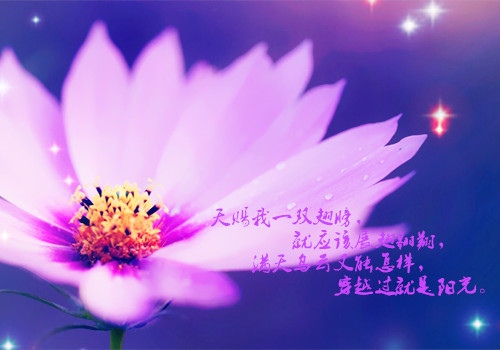
杜甫草堂的英文怎么写
叫Thatched Cottage
附你:四川-英文导游辞 Du Fu(712~770)Thatched Cottage used to be the former hone of Du Fu, one of the greatest poets in the Tang Dynasty. Located in the western suburbs of Chengdu, the spot is marked by a stream, ancient style architecture, pavilion pagodas and age -old trees. The cottage consists of six important parts, They are the Front Gate, the Lobby, the Hall of poem History, the Water Pavilion, the Gongbu Shrine and the Thatched Cottage. At the time of the Tang Dynasty, Du Fu's poetry first came to be recognized. Readers of many different periods have considered Du Fu to be the greatest poet of the Chinese tradition. Such general agreement can partially be explained by the immense variety of his work, which holds up quite well to different tastes and historical changes in fashion. Like Shakespeare in English tradition, Du Fu's poetry came to be so deeply bound up with the constitution of literary value that generation after generation of poets and critics rediscovered themselves and their interests in some aspect of the poet' Chinese critics from the Song Dynasty referred to Du Fu as thepoet-historian. Both before and after the An Lushan Revolt, Du Fu witnessed a typical political and social situation; the common people still lived in poverty while the emperor and his top officials enjoyed a foolishly luxurious life. He composed many poems such as Song of the War Chariots, Three Officials,and Three Departures。
His poems expressed his dissatisfaction with the government and his great pity for the common people. Du Fu used his poems to comment on current events and historical images. Du Fu became the historian by creating his responses to particular situations. Du Fu was talented. When he was young, he wanted to get a good job in the government. Unfortunately Du Fu was refused several times. He was in his fifties when he began to serve as a minor official in Changan (Xi'an). Gongbu was his official title and probably he was in charge of the lical industry. Du Fu was not a skilled survivor in government politics. He was dismissed in the form of a transfer to the post of personnel administrator in Huazhou and so left Changan. Du Fu soon gave up this minor post in disgust and set off with his family to Qinzhou in the Northwest. After a short stay he moved on again and in 759 he arrived in Chengdu. He set up a modest cottage with some money he borrowed from his friend who served as a local governor. In the cottage he had a simple and peaceful life for three years, writing about 240porms. Mostly inspired by the cottage, the stream nearby and the scenery in Chengdu. These poems give the impression that he was happier in Chengdu than any other time in his life. The poems of this period sound relaxed and happy. Here are some of them. In Chengdu the flutes and the strings You hear them so loud even in the daytime The melody fades in the river wind And half in the towering clouds above us Oh it should never be played here It belongs to the emperor's hraven We thank you for what is not ours But the emperor will be hearing it also Two yellow orioles sing in the tenser green willow A line of herons crosses the blue sky When you open the west-facing window The snow is framed in the summit of the mountain And the ships that will sail east for Dong Wu They lie at anchor in the sun-filled doorway A good rain knows its season It brings thins to life right in spring It enters the night, unseen with the breeze It moistens things gently and without sound Du Fu left Chrngdu after 762 and wandered in the southern provinces and eventually died of illness in 770. After his death, the people if Chrngdu built a shrine on the site of his garden to honor him. Since then, it brcame the custom to visit on the seventh day of the lunar month(around the middle of February). An ancient couplet still hangs on the top of the front door. It reads:锦江春风公占却,草堂人日我归来。
It was written by a scholar of the Qing Dynasty, whose name was He Shaoji. The couplet means that Du Fu owned the Jingjiang river and the spring breeze; on the seventh day of the first lunar month did I come to visit his cottage. The original cottage no longer exists and the buildings within the cottage compound. South west of the city, have been repaired and added to thirteen times since the eighth century. The Gongbu Shrine is at the center of the six important sites in the cottage compound……It is a small hall in the eastern section of the grounds, dedicated to the memory of Du Fu. It contains a statue of du fu flanked by ghose of two other poets; Huang Tingjian(1045-1105)on the right and Lu You (1125-1210)on the leftThesee two poets were both from the Song Dynasty and occupied an important place in the traditional Chinese literature history. Huang Ting jian, from Xiu Shui in which affected his official posts. Later when his opposition party was in power, he was dismissed from his major official post and banished to Yizhou. Huang was one of the followers of Su Shi. He sincerely studied Du Fu's poetry and intentionally car during theearly song Dynasty. Lu You, from Shaoxing in Zhejiang held a succession of mionor of ficial posts but was unable to affect any of the political reforms he advocated. Im 1172, he began to serve in the army on the Sichuan -Shaanxi border. It is known that sometime later he was dismissed from a post im jiangxi for distributing government grain to relieve famine. Lu You was a prolific poet and more than nine thousand poems have survived. Both Huang ting jian and Lu You are noted for their ardent patriotism. Here are some of their poems : Looking all round, a fine sight of hills and waters I found: Leaning on the Tower railing, I could enjoy what was sweet: The fragrance of water chestnuts and lotus stretching far The soft breeze and bright moon which were both Free and made tower cool ; (Huang tingjian, Tr, Guo Zhuzhang) Erect hedge and implant fence to shield and sustain these new bamboo, They are meticulously cultivated and their dark green color is reflected in ripples. The blowing of the cool breeze tells the early coming of autumn, And I am not aware of the blazing sun in the sky at such high noon. I hear the rustling sound when the sheath is shedding from the sprouts. And see the dense fluttering shadows of these newly grown young bamboos. Once I retire from my position, here will be the place to which I often come, And carry with me along a pillow and a mat that are made of bamboo. (Lu You, Tr. Cui Wenkai) In the traditional Chinese literature history, there were thousands of poets, Why were these two poets selected to accompany Du Fu ?there are three reasons:Firstly, they made greart achievements in studying Du Fu's poetry. Secondly, they used to live in Sichuan, and enjoyed their stay, thirdly, Du FU's statue might have been lonely in the gongbu Shrine without any accompaniment. so when people placed the statues together, they ghought that the three poets might have time to talk about their poetry. the Shrine of the Three Sages is named from the above -mentioned story. Inside the shrine are two valuable stone tablets from the Qing Dynasty, on which the whole picture of the thatched Cottage has been engraved. the tablets showus the design and development of the cottage dated bace to the Qing Dynasty. Also an other two stone tablets are in the shrine, which tell the story about the refurbishment of the cottage and the reason why Huang tingjian and Lu You's statues stay with Du Fu's. On left side of the Gongbu Shrine is a huge tablet placed in a straw -roofed pavilion. Prince Guo of the Qing Dynasty wrote the calligraphy on the tablet when he visited the cottage. A screen wall at the entrance to the Flowery Path is decorated with the characters Caotang(Thatched Cottage ) at old blue and white ceramic fragment. At present, du Fu's cottage is a museum. It has a rich collection of over 30000bound volumes, and 2000cultural relics, the bound volumes include thea ncient cut blocks photo-offset, hand -written, and modern stereotyped copies, the translation editions are in 15 languages. As you walk around the cottage, you will experience the traditional Chinese culture and literature characterized by Du Fu's poems.
有没有杜甫草堂照壁的导游词啊 急需 谢谢
杜甫草堂工部祠导游词【篇一:杜甫草堂工部祠】杜甫草堂工部祠各位朋友:大家好
“锦水春风公占却,草堂人日我归来”。
这是悬挂在成都西郊杜甫草堂工部祠门前的一副名联。
我们大家都知道,杜甫是我国唐代伟大的现实主义诗人,有“诗圣”之称。
虽然他才华横溢,有远大的政治抱负,但仕途却不得志。
因为他曾做过检校工部员外郎的官,人称杜工部。
所以这座供奉他塑像和供人祭祀的享殿就叫工部祠。
我们现在所看到的工部祠三个字是由我们现代著名文学家、教育家叶圣陶先生所书。
祠前这副名联是由清代著名学者、书法家何绍基撰写的。
同时这副对联也是杜甫草堂中仅存的作者自书联文,非常珍贵。
过去多认为何绍基此联一出,春游草堂遂改为人日。
其实啊,人日是农历的正月初七,在人日踏春是古以有之的巴蜀风俗。
而人日思念故乡、怀念故人的习俗也曾一度流行于黄河上下,大江南北。
至于咱们成都人何故择人日游草堂则牵涉到了杜他的好友高适的一段友谊。
杜甫和高适两人年青时曾一起遍游祖国的名山大川,饮酒赋诗,畅论国事,结为诗友。
杜甫避乱入蜀之时,正值高适在成都附近做官,杜甫在成都生活的几年间,除了靠卖草药为生以外,其生活所需的绝大部分来源还靠高适和其他朋友的慷慨资助。
杜甫和高适因此留下了许多酬答唱和的诗章。
公元和仰慕之情,择人日到草堂吟诗题联,寻踪问古,最终成为了一种民间习俗并且延续到了今天。
特别是现在杜甫草堂博物馆现在举行悬赏百万元征集
谁有青羊宫英语导游词啊
我是你们的导游解静琦,你们可以叫我小解。
今天我们来北京故宫游玩。
我将带大家参观故宫博物院,现在我先为大家作个简单介绍。
故宫位于北京市城区中心,是明、清两代的皇宫,是当今世界上现存规模最大、建筑最雄伟、保存最完整的古代皇家宫殿。
故宫又叫紫禁城。
我们现在从天安门进入,它是故宫外围皇城的南门。
过了天安门,越过端门,迎面就是高大的午门。
午门是故宫的正门。
进入午门,首先映入眼帘的就是内金水河,它自西向东蜿蜒流过太和门广场。
过了桥,在我们面前这座宏伟的建筑就是太和殿了,它和中和殿还有保和殿是建立在一个土字型的三层台基上,在四周围还建有一些楼阁。
太和殿是故宫中最高最大的建筑。
殿内的陈设也非常的多。
金銮宝所座是明代的遗物。
来到中和殿了。
皇帝在此阅视奏书。
殿名体现了儒家的中庸思想在明清两代举行大的潮礼时候,皇帝在赶赴太和殿之前,都要在中和殿稍作休息,接受官员朝贺。
过了中和殿,我们就来到了保和殿,名称来源于太和殿相同,都是保合大和之意。
保和殿在明清两代用途不同。
明朝的时候,在举行册立大典的时候,皇帝都要在保和殿内更衣。
在清朝的时候,每逢正月十五,除夕,也都要在此举行宴会。
在保和殿后,有一个巨大的云龙石雕,是艾叶青石雕刻而成的。
各位游客,这次的旅游到此结束。
如果还想来的话就记得找我哦
杜甫草堂有几个大门?从浣花北路去杜甫草堂应该走哪个门?
杜甫草堂的金沙遗址的武侯祠青城山 参考资料,你可以加一些自己的东西进去,灵活一点啦,希望能帮到你
成都市各大旅游景点英文名称
成都市的旅游景点称如下:金沙遗址:Jinsha Ruins熊猫基地:Chengdu Panda Base院:Wenshu Temple锦里古街:Jinli Ancient Street宽窄巷子:Kuai Zhai Zane都江堰水利工程:Dujiangyan Irrigation Project乐山大佛:Leshan Giant Buddha庐山:Mt.Lushan武侯祠:Wuhou Temple峨眉山:Mt. Emei青城山:Mt.Qingchengshan四姑娘山:Mt. Siguniang九寨沟:Jiuzhaigou Valley三星堆:Sanxingdui世界自然遗产:the World Natural Heritage杜甫草堂:Dufu's Thatched Cottage青羊宫:Qingyang Temple金沙遗址:Jinsha Ruins摩梭族:Mosuo宝光寺:Baoguang Temple自贡国家恐龙地质公园:Zigong NationalGeological自贡大山铺:Dashanpu of Zigong武侯祠:Wuhou Temple九寨沟:Jiuzhaigou Valley三星堆遗址:the site of Sanxingdui世界自然遗产:the World Natural Heritage都:the Dujiangyan Dam杜甫草堂:Dufu Thatched Cottage青羊宫:Qingyang Taoist Temple武侯祠:Temple of Marquis都江堰:Doujiang Weir九寨沟:Jiuzhaigou蜀南竹海:Bamboo Sea三星堆遗址:Sanxingdui



